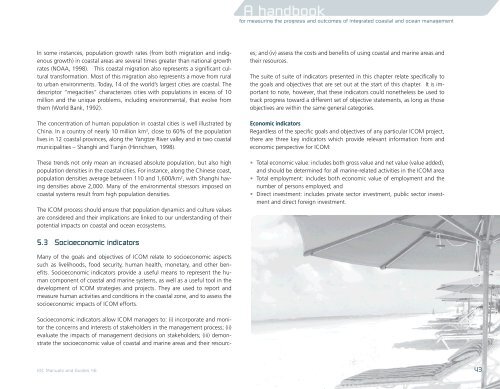5 - unesdoc - Unesco
5 - unesdoc - Unesco
5 - unesdoc - Unesco
Create successful ePaper yourself
Turn your PDF publications into a flip-book with our unique Google optimized e-Paper software.
In some instances, population growth rates (from both migration and indigenous<br />
growth) in coastal areas are several times greater than national growth<br />
rates (NOAA, 1998). This coastal migration also represents a significant cultural<br />
transformation. Most of this migration also represents a move from rural<br />
to urban environments. Today, 14 of the world’s largest cities are coastal. The<br />
descriptor “megacities” characterizes cities with populations in excess of 10<br />
million and the unique problems, including environmental, that evolve from<br />
them (World Bank, 1992).<br />
The concentration of human population in coastal cities is well illustrated by<br />
China. In a country of nearly 10 million km 2 , close to 60% of the population<br />
lives in 12 coastal provinces, along the Yangtze River valley and in two coastal<br />
municipalities – Shanghi and Tianjin (Hinrichsen, 1998).<br />
These trends not only mean an increased absolute population, but also high<br />
population densities in the coastal cities. For instance, along the Chinese coast,<br />
population densities average between 110 and 1,600/km 2 , with Shanghi having<br />
densities above 2,000. Many of the environmental stressors imposed on<br />
coastal systems result from high population densities.<br />
The ICOM process should ensure that population dynamics and culture values<br />
are considered and their implications are linked to our understanding of their<br />
potential impacts on coastal and ocean ecosystems.<br />
5.3 Socioeconomic indicators<br />
Many of the goals and objectives of ICOM relate to socioeconomic aspects<br />
such as livelihoods, food security, human health, monetary, and other benefits.<br />
Socioeconomic indicators provide a useful means to represent the human<br />
component of coastal and marine systems, as well as a useful tool in the<br />
development of ICOM strategies and projects. They are used to report and<br />
measure human activities and conditions in the coastal zone, and to assess the<br />
socioeconomic impacts of ICOM efforts.<br />
Socioeconomic indicators allow ICOM managers to: (i) incorporate and monitor<br />
the concerns and interests of stakeholders in the management process; (ii)<br />
evaluate the impacts of management decisions on stakeholders; (iii) demonstrate<br />
the socioeconomic value of coastal and marine areas and their resourc-<br />
IOC Manuals and Guides 46<br />
A handbook<br />
for measuring the progress and outcomes of integrated coastal and ocean management<br />
es; and (iv) assess the costs and benefits of using coastal and marine areas and<br />
their resources.<br />
The suite of suite of indicators presented in this chapter relate specifically to<br />
the goals and objectives that are set out at the start of this chapter. It is important<br />
to note, however, that these indicators could nonetheless be used to<br />
track progress toward a different set of objective statements, as long as those<br />
objectives are within the same general categories.<br />
Economic indicators<br />
Regardless of the specific goals and objectives of any particular ICOM project,<br />
there are three key indicators which provide relevant information from and<br />
economic perspective for ICOM:<br />
• Total economic value: includes both gross value and net value (value added),<br />
and should be determined for all marine-related activities in the ICOM area<br />
• Total employment: includes both economic value of employment and the<br />
number of persons employed; and<br />
• Direct investment: includes private sector investment, public sector investment<br />
and direct foreign investment.<br />
43

















